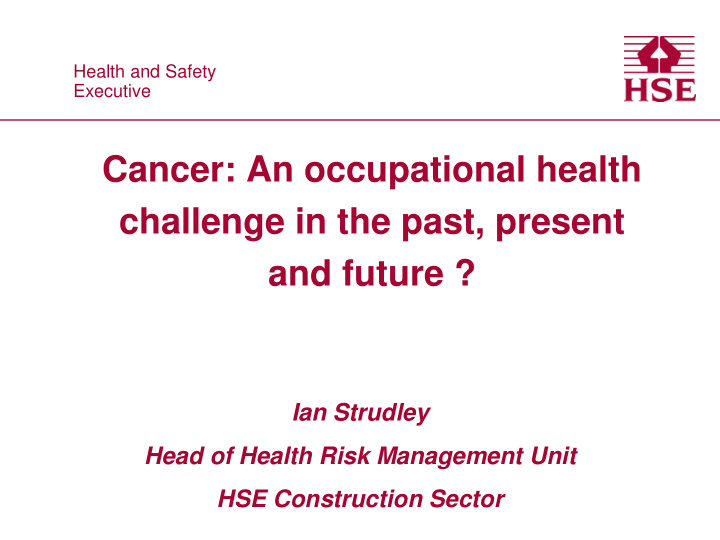



Health and Safety Health and Safety Executive Executive Cancer: An occupational health challenge in the past, present and future ? Ian Strudley Head of Health Risk Management Unit HSE Construction Sector
What I’ll do….. • What’s the problem ?.......... • What priorities are HSE ( and IOSH !) taking forward…. • What’s next ????
Together, we can make a difference
Burden of occupational cancer Lesley Rushton et al Imperial College London: http://www.nature.com/ bjc/journal/v107/n1s/index.html
Top 10 causes of cancer registrations attributable to occupational carcinogens (Rushton/HSE) Rank Agent/activity Number of Registrations/year 1 Asbestos 4216 2 Shiftwork 1957 3 Mineral oils 1730 4 Solar radiation 1541 5 Silica 907 6 Diesel engine exhaust 801 7 Coal tars and pitches 545 8 Painters 359 9 Tertachlorodibenzodioxin 316 10 Tobacco 284
Where’s the problem…? 6000 5000 Number of Registrations 4000 Total Registrations 3000 Construction Workers 2000 1000 0 NMSC Mesothelioma Bladder Brain Larynx Lung Nasopharynx Sinonasal Stomach Oesophagus Cancer Site
What’s causing the problem ? 4500 4000 3500 Numbers affected 3000 Total Registrations 2500 Construction Registrations 2000 Construction Deaths 1500 1000 500 0 n E d s r s a t s e ' o s a r o E H c e u h e i t i t D A t l d s a t L i n O S e P i i d d a b o a s P R o A W r a l o S
Silica
In Practice industry adopted controls
Is there still a problem ? : 2014 Health Initiative • 13 Prohibition Notices; • 108 Improvement Notices • 267 Notices of Contravention issued at 146 sites Improvement Notices Notices of Contravention Dust Dust Welfare Welfare MSD MSD Vibration Vibration Other Substances Other Substances Noise Noise Other (Management)
Is there still a problem ? 2014 Refurbishment Initiative • Health and Safety Inspection of smaller refurb sites: – 537 Notices (including 2 ELCI) – 314 PNs (including 46 on health) – 221 INs (including 92 on health) Prohibition Notices Improvement Notices Asbestos Dust Manual Handling Asbestos Dust Noise Vibration Welfare 2% 26% 36% 46% 52% 34% 3% 1%
Diesel Engine Exhaust Emissions Is there still a problem? • Tight emission standards • Better technology / fuel But: • More diesel plant in use • Work conditions – location, engine power and use
DEEEs: Filling the Knowledge Gap • General Research into: 1. Engine and fuel technology 2. Occupational exposures 3. Health outcomes 4. Exposure monitoring markers 5. Undertake on-site monitoring • Construction Specific
DEEEs: Emission Trends UK National Atmospheric Emissions Inventory (NAEI): • ‘mobile combustion in manufacturing industries and construction ’ using ‘red diesel’ (Gas Oil) 100 90 80 70 60 PM1 Kilotonnes 50 40 Nitrogen Oxides (as NO2) 30 Carbon Monoxide 20 10 0 2002 2003 2004 2005 2006 2007 2008 2009 2010 2011 2012
DEEEs: Next Steps • Control principles remain the same – COSHH Hierarchy • Finalise research • Industry engagement
What to do .….? Occupational Risks v Lifestyle Issues
What to do …..? Surveillance/Monitoring? Risk Control?
HSE website guidance : How healthy is your business? http://www.hse.gov.uk/construction/healthrisks/index.htm
IOSH : campaign on occupational cancer
IOSH - No time to lose …. • 50+ work-related carcinogens – focusing on : – Diesel engine exhaust – Solar radiation – Silica – Shiftwork – Asbestos
IOSH - No time to lose …. www.notimetolose.org.uk
What’s next ? Think Health! –Greater focus on health, not just by HSE…
Thank you for listening any questions ? Ian Strudley HM Principal Inspector Head of Health Risk Management Unit Construction Division HSE 01256 404085 ian.strudley@hse.gsi.gov.uk
Recommend
More recommend